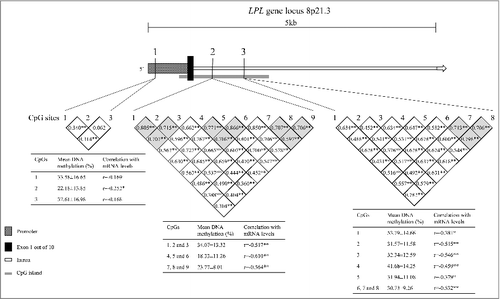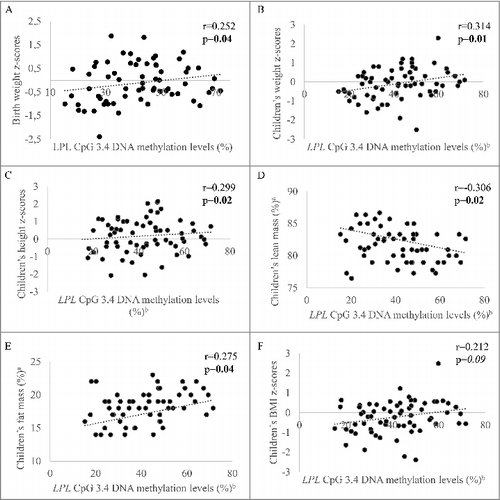Figures & data
Table 1. Clinical characteristics of mothers and offspring from first trimester of pregnancy to 5 y of age.
Figure 1. Schematic representation of the LPL gene and localization of the three epigenotyped regions. Region 1, containing 3 CpG sites, is located within the proximal promoter of the LPL gene. Regions 2 and 3, containing respectively 9 and 8 CpG sites, are located in the first intron of LPL gene, downstream the first exon. The grey square represents a CpG island. *p < 0.05; **p > 0.01.

Table 2. Placental DNA methylation levels at the LPL loci in children exposed and not exposed to gestational diabetes mellitus during fetal development.
Table 3. Growth in children exposed and not exposed to gestational diabetes mellitus during fetal development.
Figure 2. Comparison of anthropometric profiles in GDM and NGT offspring with WHO recommendations. A. Children's weight and; B. BMI z-scores were compared to WHO references using a one-sample T-test (with 0 as comparing group). Dotted line represent the WHO growth chart reference for boys and girls. The mean z-score is indicated by a bold grey line.

Figure 3. Associations between birth weight and body composition at age 5. Spearman correlation was evaluated between birth weight and children's A. weight and; B. BMI. p values are adjusted for children's age and sex. p values ≤0.05 are indicated in bold and p values <0.1 are in italic.

Figure 4. Associations between placental DNA methylation levels at LPL CpG dinucleotide 3.4 and children's body composition. Spearman correlation between DNA methylation levels and A. birth weight and children's; B. weight; C. BMI; D. height; E. lean mass and; F. fat mass. ap values adjusted for children's age and sex; bp values adjusted for gestational age and sex. p values ≤0.05 are indicated in bold and p values <0.1 are in italic.

